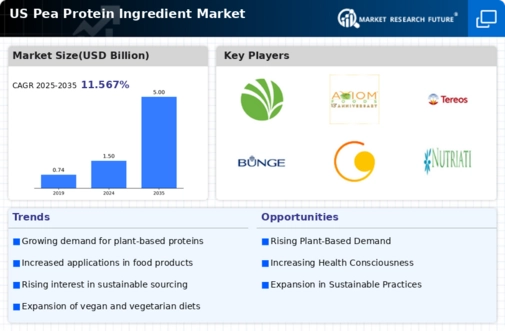The US Pea Protein Ingredient Market is characterized by a rapidly growing interest from both consumers and manufacturers, driven by a shift toward plant-based dietary choices. As demand for sustainable protein alternatives increases, a variety of companies are entering the space, offering an array of products that cater to health-conscious consumers. Competitive dynamics in this market reveal players focusing on innovation, quality, and supply chain efficiencies. Companies are investing in research and development to enhance the nutritional profile and functional properties of pea proteins while ensuring they meet the diverse needs of food manufacturers and end-users.
Furthermore, strategic partnerships and collaborations are increasingly common, as competitors seek to strengthen their market presence and leverage unique capabilities to capture a share of the burgeoning market.
Ingredion has established a strong foothold in the US Pea Protein Ingredient Market through its commitment to quality and innovation. This company has developed a range of pea protein products that are recognized for their superior functional properties, making them desirable for use in various food applications. Ingredion's strengths stem from its extensive research capabilities and a broad distribution network, which allows for efficient product delivery to customers across multiple sectors. The company has also focused on sustainability and transparency, aligning with consumer preferences for ethically sourced ingredients, which further enhances its market position.
Additionally, Ingredion is known for its ability to customize solutions to meet unique customer requirements, making it a preferred supplier in the industry.
The Pea Protein Industry Association plays a significant role in shaping the landscape of the US Pea Protein Ingredient Market by advocating for the interests of stakeholders in the pea protein sector. This association is instrumental in promoting best practices, facilitating knowledge sharing, and supporting research initiatives that enhance the competitiveness of pea protein products. Key services provided by the Pea Protein Industry Association include market insights, educational resources, and networking opportunities for companies involved in the production and use of pea protein.
The association also works to connect industry players and promote collaborations that can lead to innovations and advancements in the market. With an emphasis on fostering growth and ensuring the sustainability of pea protein production, the Pea Protein Industry Association is a pivotal entity that strengthens the overall market ecosystem in the US region.


















Leave a Comment